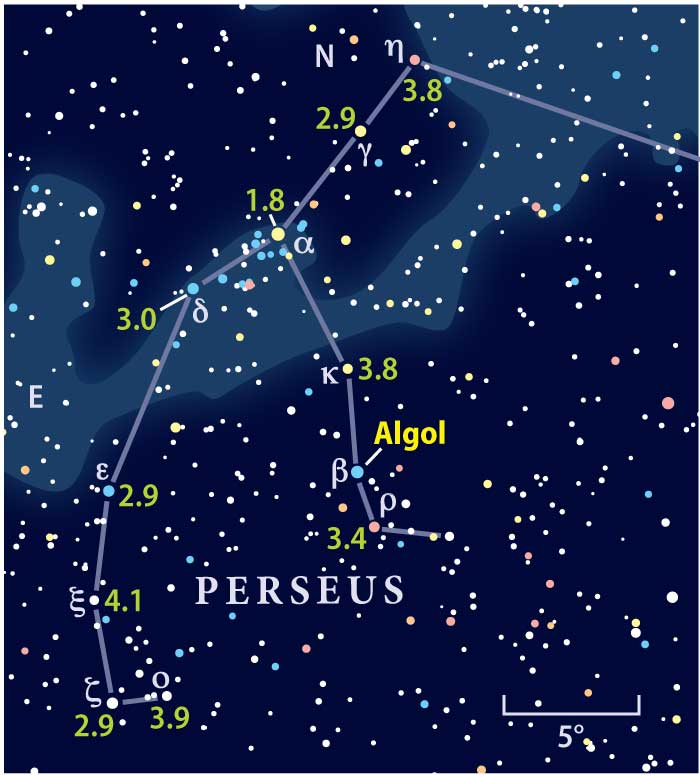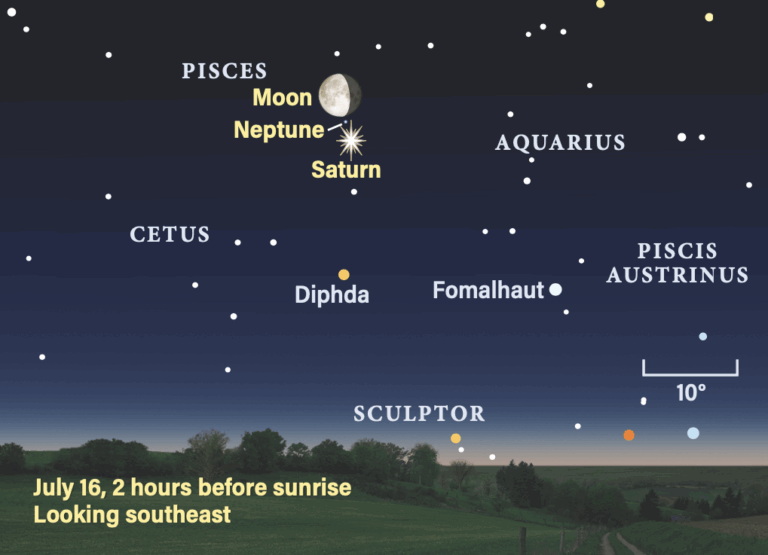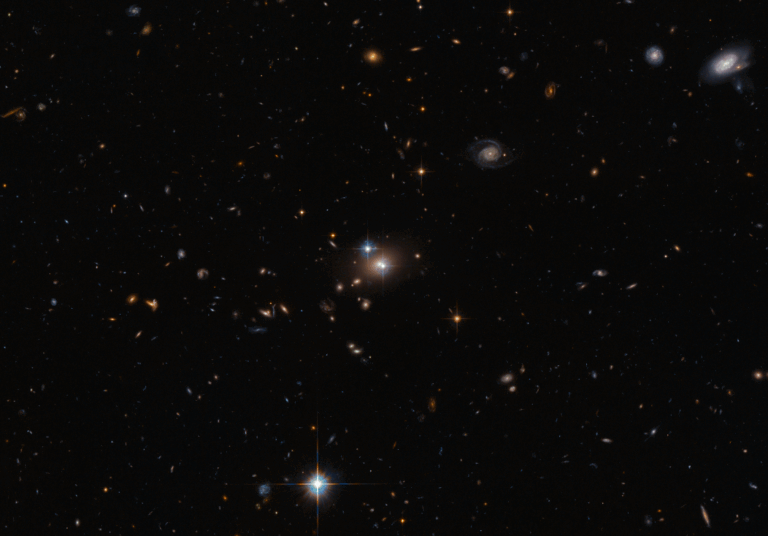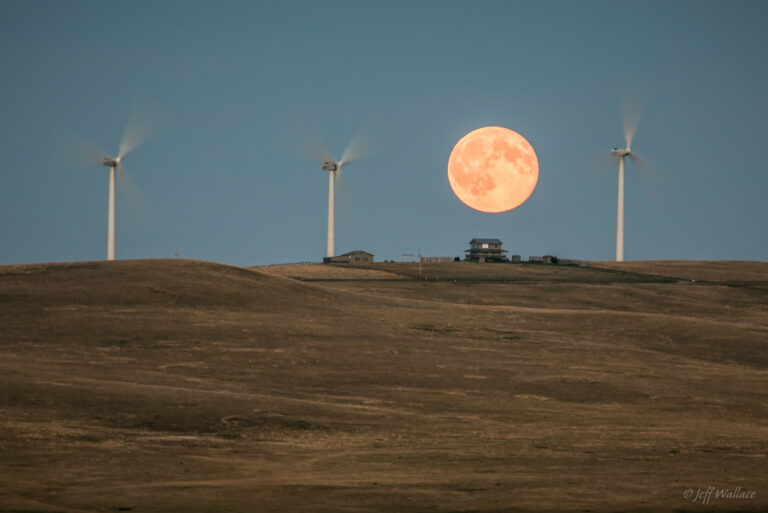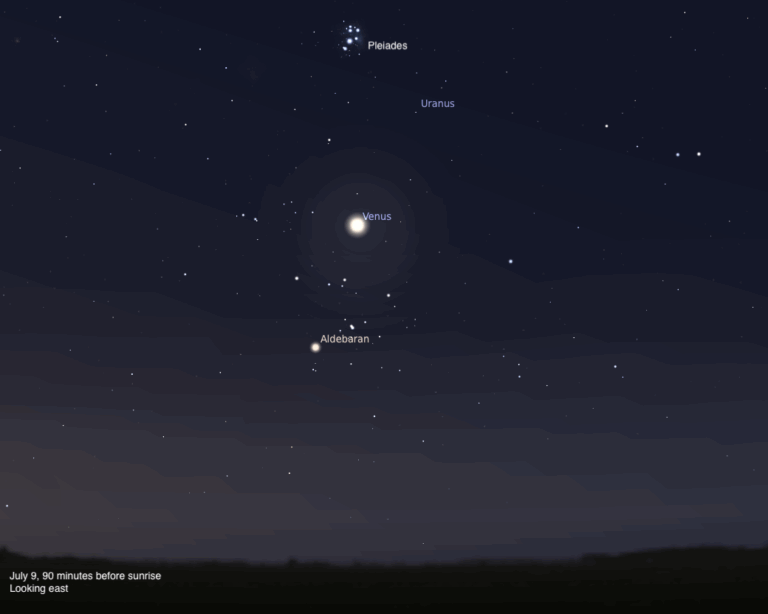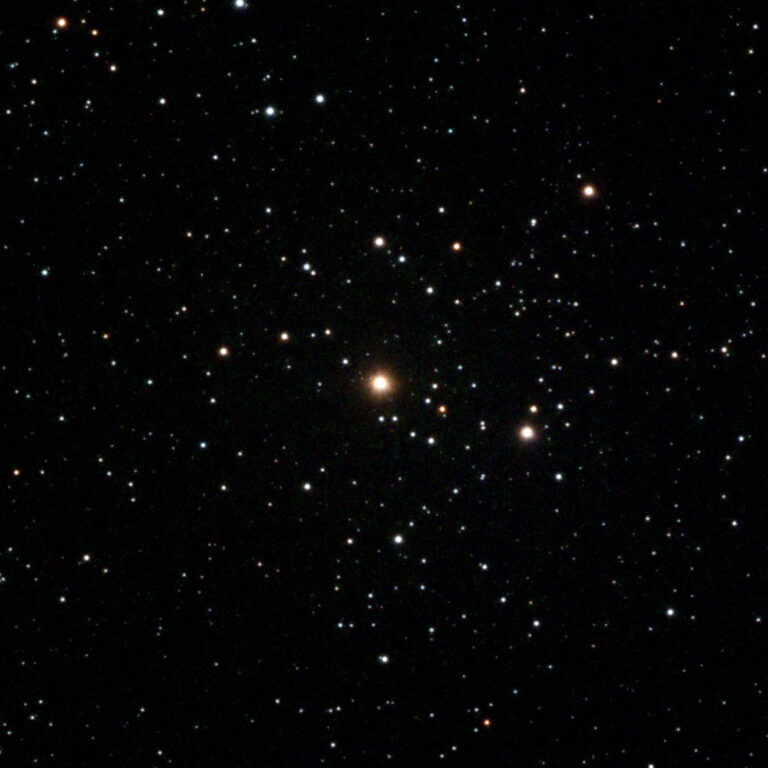Key Takeaways:
The days of viewing Saturn in the evening sky are dwindling rapidly. You can find the ringed world 10° above the southwestern horizon an hour after sunset. To find it, target brilliant Venus with binoculars and then look half a field of view to the lower right. Saturn shines at magnitude 0.6, some 60 times fainter than Venus but more than a full magnitude brighter than any of the background stars in its host constellation, Sagittarius the Archer. Although the best views of Saturn through a telescope came earlier in this apparition, it never hurts to take a final look. This week, the planet’s disk measures 15″ across while the ring system spans 35″ and tilts 24° to our line of sight.
Saturday, December 14
The annual Geminid meteor shower reaches its peak tonight. Unfortunately, a nearly Full Moon shares the sky with the meteors nearly all night and will drown out the shower’s fainter members. Under clear skies, attentive observers could see perhaps 10 to 15 meteors per hour. Your best option is to observe from a rural location, where the lights of the city won’t add to the Moon’s glow.
Sunday, December 15
Mercury remains a fine sight in morning twilight early this week. The innermost planet shines at magnitude –0.6 and appears 6° above the southeastern horizon 30 minutes before the Sun rises. That’s bright enough to see with the naked eye, although binoculars will help you to pick it out of the twilight glow. If you have an exceptionally clear sky and an unobstructed horizon, you also might spot the 1st-magnitude star Antares 5° south (lower right) of Mercury this morning. A view of the planet through a telescope reveals its 5″-diameter disk and nearly full phase.
With December now well underway, people’s thoughts naturally turn to the onset of winter. As if on cue, the coldest season’s most conspicuous constellation now appears prominent in the evening sky. Orion the Hunter lies low in the east at 7 p.m. local time and climbs to its peak due south around midnight. Look for three 2nd-magnitude stars in a short line that form the Hunter’s Belt. The constellation’s brightest stars are ruddy Betelgeuse and blue-white Rigel.
Tuesday, December 17
This evening offers an exceptional chance to spot the 10th-largest member of the asteroid belt, a collection of at least several hundred thousand objects that lies between the orbits of Mars and Jupiter. Tonight brings a perfect opportunity to track down asteroid 15 Eunomia because it slides just 0.8° south of magnitude 2.9 Alpha (α) Aquarii, the second-brightest star in the constellation Aquarius, which lies about 20° southwest of the southwestern corner of the Great Square of Pegasus. Eunomia glows at 10th magnitude, however, so you’ll need a small telescope to pick it up.
Wednesday, December 18
Last Quarter Moon occurs at 11:57 p.m. EST. You will see it poking above the eastern horizon minutes before midnight local time and peaking high in the south shortly after twilight starts to paint the sky Thursday morning. The half-lit Moon spends the morning hours in the western part of the constellation Virgo the Maiden. If the Moon looks a bit bigger than normal, it may not be your imagination. Our satellite reaches perigee, the closest point in its orbit around Earth, at 3:25 p.m. EST today. It then lies 230,072 miles (370,265 kilometers) from Earth’s center.
Thursday, December 19
Venus gleams in the southwestern sky after sunset. The brilliant planet stands out just a half hour after sunset, when it appears 15° above the horizon, and remains on display until 7 p.m. local time. Shining at magnitude –3.9, it is by far the brightest celestial object in the evening sky. If you wait until the sky grows dark and target the planet through large binoculars or a telescope with a low-power eyepiece, you’ll see the 9th-magnitude globular star cluster M75 just 0.5° to its west. The cluster lies at the eastern edge of the constellation Sagittarius, while Venus resides in far western Capricornus, having crossed the border earlier today. A telescopic view shows Venus’ 12″-diameter disk and 85-percent-lit phase.
Friday, December 20
Although the calendar says December, the Summer Triangle of bright stars remains prominent during the early evening. Look for this large asterism in the western sky after darkness falls. Approximately one-third of the way to the zenith lies the Triangle’s brightest member, magnitude 0.0 Vega in the constellation Lyra. Nearly 25° above Vega lies magnitude 1.3 Deneb in Cygnus. And 35° to Vega’s left lies magnitude 0.8 Altair in Aquila. Altair sets around 9:30 p.m. local time, destroying the geometric pattern.
Saturday, December 21
Earth’s winter solstice occurs at 11:19 p.m. EST. At that moment, the Sun reaches its farthest point south in the sky. The solstice marks the official beginning of winter in the Northern Hemisphere, and tonight has more hours of darkness than any other. From mid-northern latitudes, however, the earliest sunset occurred about two weeks ago and the latest sunrise won’t happen until early January.
If you’re game for a quick evening challenge, try to spot Neptune through binoculars. The distant planet lies halfway to the zenith in the south-southwest near the end of evening twilight and doesn’t set until nearly 11 p.m. local time. The magnitude 7.9 world appears against the backdrop of Aquarius, 1.3° west-southwest of the 4th-magnitude star Phi (φ) Aquarii. You’ll need binoculars to spy Neptune and a telescope to see its blue-gray disk, which spans 2.3″.
The Ursid meteor shower peaks tonight. The shower’s radiant — the point from which the meteors appear to originate — lies in the constellation Ursa Minor, near the bowl of the Little Dipper. The radiant is visible in the north all night, but it climbs higher as dawn approaches. And the waning crescent Moon won’t interfere much even after it rises around 4:30 a.m. local time tomorrow morning. Observers with clear skies typically see 5 to 10 Ursid meteors per hour at the peak, but astronomers predict a possible enhancement this year that could briefly double or triple the normal rate.
Ruddy Mars grows more prominent before dawn with each passing week. The Red Planet now rises by 4:30 a.m. local time and climbs 20° above the southeastern horizon an hour before sunrise. Mars glows at magnitude 1.6, which is a full magnitude brighter than any of the background stars belonging to its host constellation, Libra the Scales. But there is a brighter object lurking in Libra: a waning crescent Moon. Luna stands 9° above Mars this morning; tomorrow morning, it will be 6° to the planet’s lower left. Unfortunately, a telescope doesn’t add much to the view of Mars, revealing a bland disk just 4″ across.






